A month-by-month guide to the best border plants

Succession in gardening is about as far removed from the blockbuster TV series as you can get, but it does involve dirt and glamour. Succession planting is the holy grail of gardening – creating a display of border plants that looks good for 12 months of the year. And a wise gardener once said that if you have at least one plant in bloom for every month of the year, you're part of the way to achieving that horticultural nirvana.
It's certainly a good design goal to aspire to and one that helps justify a monthly trip to the garden centre or your favourite online nursery to see what's in season. Treat yourself to one plant that's at its peak every month and you'll be guaranteed a succession of gorgeous plants to mark each month through the changing seasons.
They don't have to be the big showstoppers – it's important to think about companion plants that work well with other border favourites. Think about textures and colour schemes, height and shape, to create a visual rhythm through your planting scheme.
Look for plants that will reward you year after year and that are easy to divide or take cuttings from, then you can add to your stock. By using the same plant in lots of different parts of your garden, this ticks another key design box by repeating shapes and colour for a unified look.
Here's a 12-month guide to some fabulous border plants.
April border plant: Euphorbia
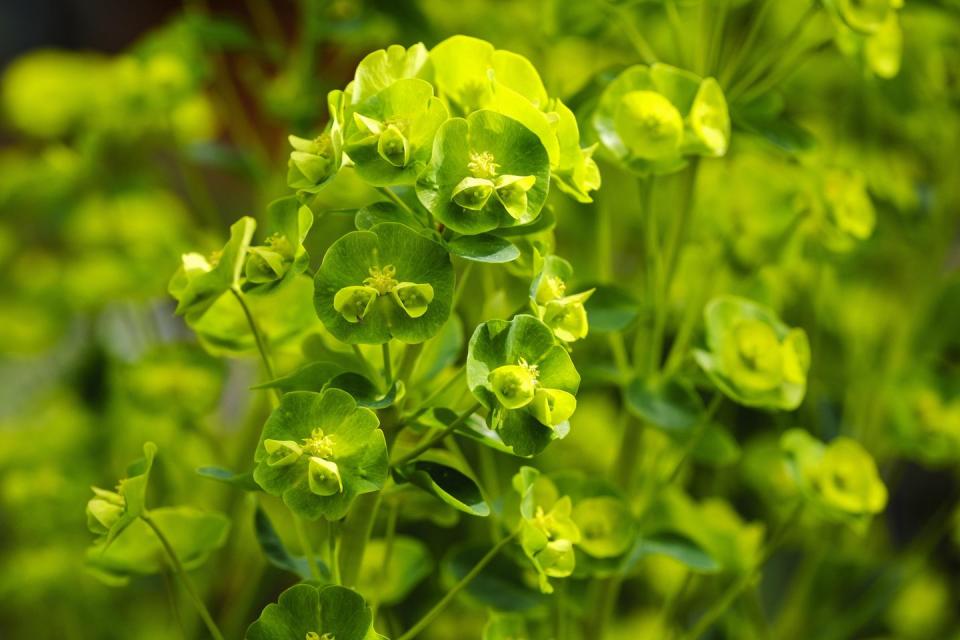
The waves of colour are coming thick and fast this month with tulip season and their many spring-flowering cohorts. But what's needed amid all this lush, fresh growth and the kaleidoscope of emerging colours is some good evergreen structure and texture to bring a little order to the flower frenzy. It doesn't have to be bold, clipped evergreens such as yew, pittosporum, or bay trees. Try instead the more subtle, sage-coloured green of the fan-shaped, bottlebrush-stemmed Euphorbia characias wulfenii. With its quite bold architectural form, this plant – commonly called spurge – will bring good contrast and texture to a border plus the added bonus of brilliant lime green flowers.
As a plant with Mediterranean origins, it's one for a sunny spot and well-drained soil which makes it good for gravel gardens. Plant it as a feature plant in a spring border, alongside bulbs and other Mediterranean plants such as herbs, grasses and summer flowering perennials for contrast. By planting Euphorbia you create a pool of green colour in your borders, which gives the eye a resting place between the pops of flower colour. As the Euphorbia flowers die, cut back the stems right to the base, but mind the white sap as it will irritate the skin.
May border plant: Peonies
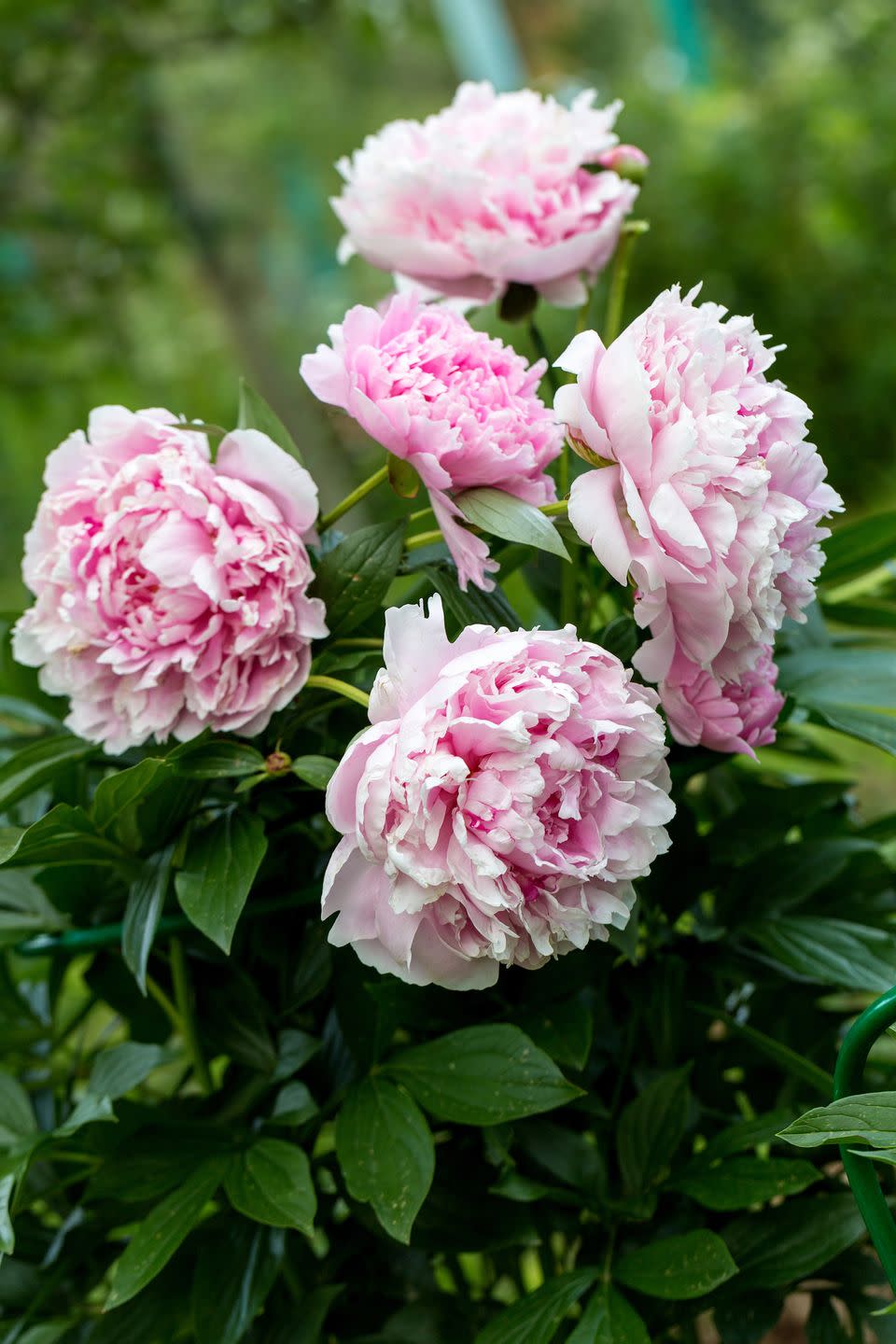
If you're looking for glamour and outrageous colour, you definitely need peonies in your garden. Partly because of their blousy good looks and slightly fussy habits, these are often considered prima donna plants. But if you have the right conditions, they are so rewarding to grow for the simply stunning flowers.
There are two types of peony: herbaceous and tree peonies. Herbaceous peonies need sunny, very well-drained conditions and rich soil. Choose your spot carefully as they take a long time to settle and bloom and they don't like being moved. But once they have found their feet, they last for decades – so this is a forever plant! Classic varieties like 'Sarah Bernhardt' will bloom profusely but the flowers are heavy so get your plant supports in place early and the stems will grow up and through them.
Tree peonies are shrubby, with taller, woody stems, and are a little bit easier to grow, but the blooms are no less fabulous. Try 'Cardinal Vaughan' for sumptuous crimson flowers. Tree peonies will tolerate some shade and are not quite so picky about their soil conditions. You can plant peonies in autumn or spring, adding plenty of well-rotted compost to the soil and feed in the spring with seaweed-based fertiliser.
June border plant: Roses

There's nothing quite like the appearance of the first rose to mark the arrival of summer. Every garden should have at least one, and whether it's a climber, rambler or classic shrub rose, there will be one to suit most growing conditions. Shrub roses don't have to be planted out as a traditional rose garden – they can look just as good in a mixed border, and vertical growers are great at the back of a border, trained up a fence or wall.
Go for a classic rose such as powder pink, deliciously scented climber 'Albertine', or choose from the many newer hybrids offering combinations of scent, colour and good looks. And don't be daunted by rose jargon, such as floribundas, hybrid tea, damask and rugosa as most rose specialists have the option for you to search by colour, scent, soil type and aspect, making it easier to choose the right specimen for the right spot. If you're worried about the care involved, most modern roses are bred to be much tougher in terms of pests and diseases, but they will need feeding and regular deadheading to keep them flowering right through the summer.
July border plant: Hardy geraniums
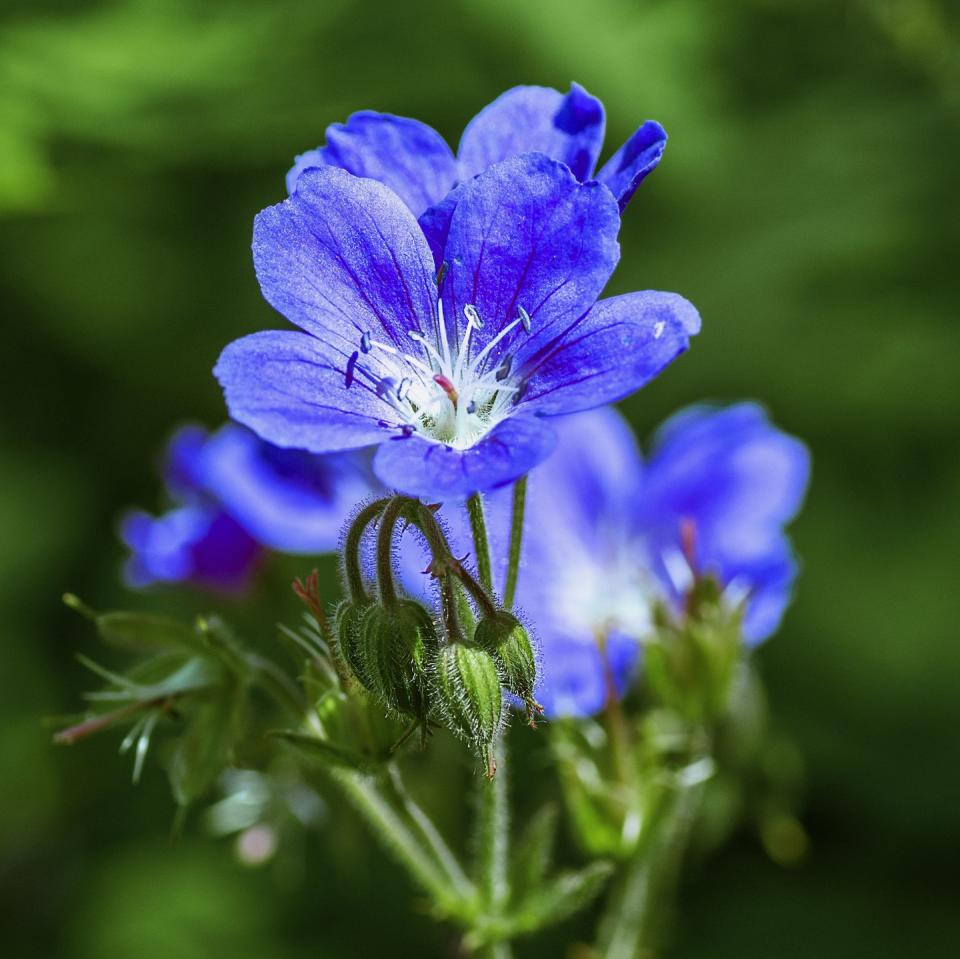
Hardy geraniums are the perfect summer border plant, often with semi-evergreen foliage and small, but brilliantly colourful flowers. Also known as cranesbill, they are easy to grow, with varieties that suit shade or sunshine, and flowers that keep coming to the delight of both humans and pollinating insects alike. A classic cottage garden perennial, they are a must for every type of garden situation. Mostly low-growing, they work best at the front of a border, spilling over the edges.
One of the most popular varieties that really embodies the best traits of geraniums is G. 'Rozanne', with bright purple flowers with pale centres that keep coming from June through to September, with just a little bit of deadheading required. Geraniums make good ground cover plants and will spread, so plant with other summer flowering perennials, lavenders and sages, or at the foot of a rose bush for ground cover. They are easy to propagate by dividing plants in autumn and spring.
August border plant: Dahlias
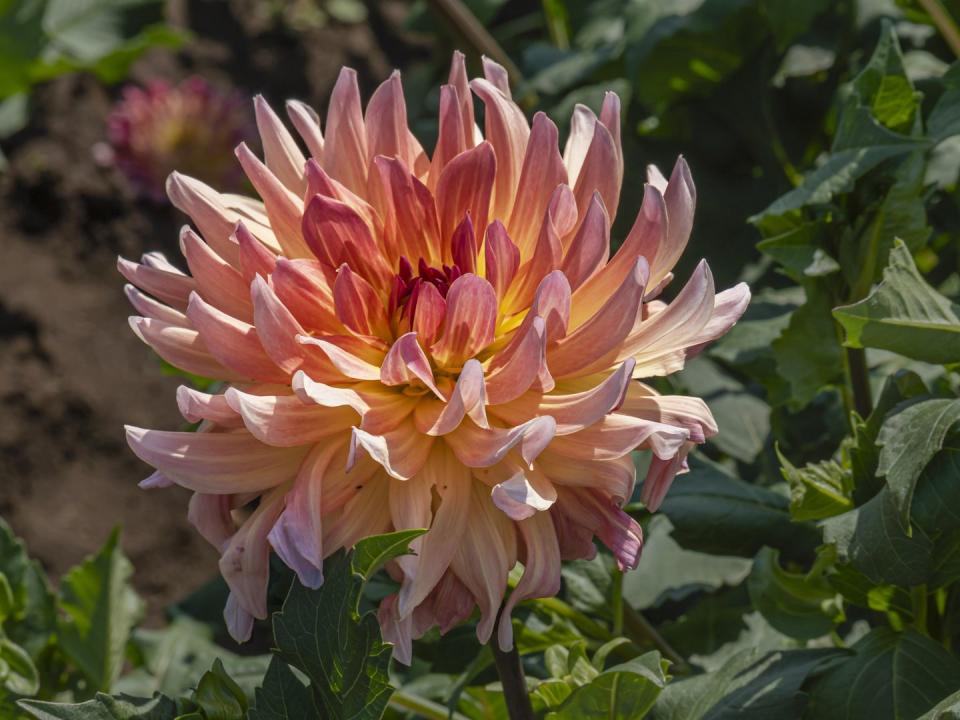
Dahlia season is a riot of colour and now they have emerged from an unfashionable dormant phase, competitive dahlia growing positively floods social media with the hottest colours and biggest blooms. Choose from simple single flowers like the dark-stemmed classic 'Bishop of Llandaff', doubles, cactus, orchid types, pompoms and more, in shades of palest blushed white through to the most vibrant reds and oranges. Dahlias need tending, feeding, and often support and staking, to show them at their best. The long flowering season means that many will continue to produce flowers until the first frosts, so they really are worth the effort. With the added bonus of making good cut flowers, you can enjoy them indoors as well.
If you want to join the dahlia party, you need to get started in spring, planting tubers early in pots and, when the weather is steadfastly warm, either plant them out or plunge plastic pots into your borders – which makes it easier when it comes to digging them up to overwinter them. It is possible to leave the tubers in the ground, provided the soil is not too heavy and damp and they have been well-mulched to protect against winter frosts.
September border plant: Sedums / Hylotelephium
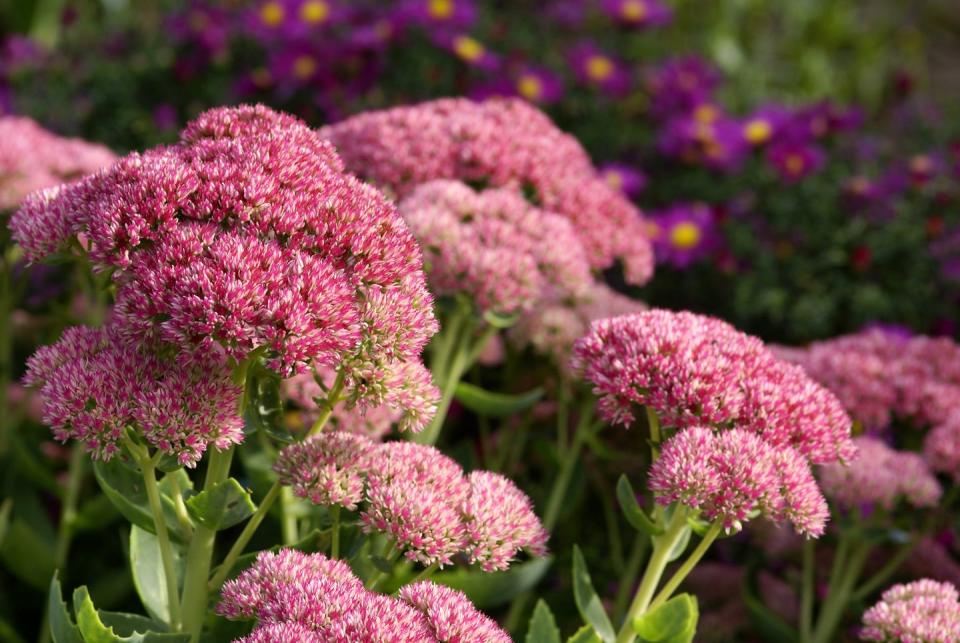
Now known as hylotelephium, but often still labelled as sedums (and also known as stonecrop), these tactile plants will bring a lovely warm, seasonal feel to your garden border. The textural, fleshy leaves are quite architectural, while the flat-headed clusters of tiny flowers make soft, cushioned landing platforms for the pollinating insects that love them. There are many varieties, from the atropurpureum types, with rich, dark purple foliage and smaller blooms, or the paler varieties such as 'Herbstfreude', with bright green foliage and large clusters of pink flowers. The straight stems make this a good candidate for cut flower arrangements.
Best in sunshine in well-drained soils, these perennials flower from late summer and will die back over winter, but the spent flowers often look attractive left on the plant and can be cut back in late winter. Plants can get quite congested at the centre over time, causing stems to fall outwards, so they will need rejuvenating by division. Simply dig them up in spring and split the clump with a sharp spade, planting up your new, free plants and adding to your collection of hylotelephiums.
October border plant: Salvias
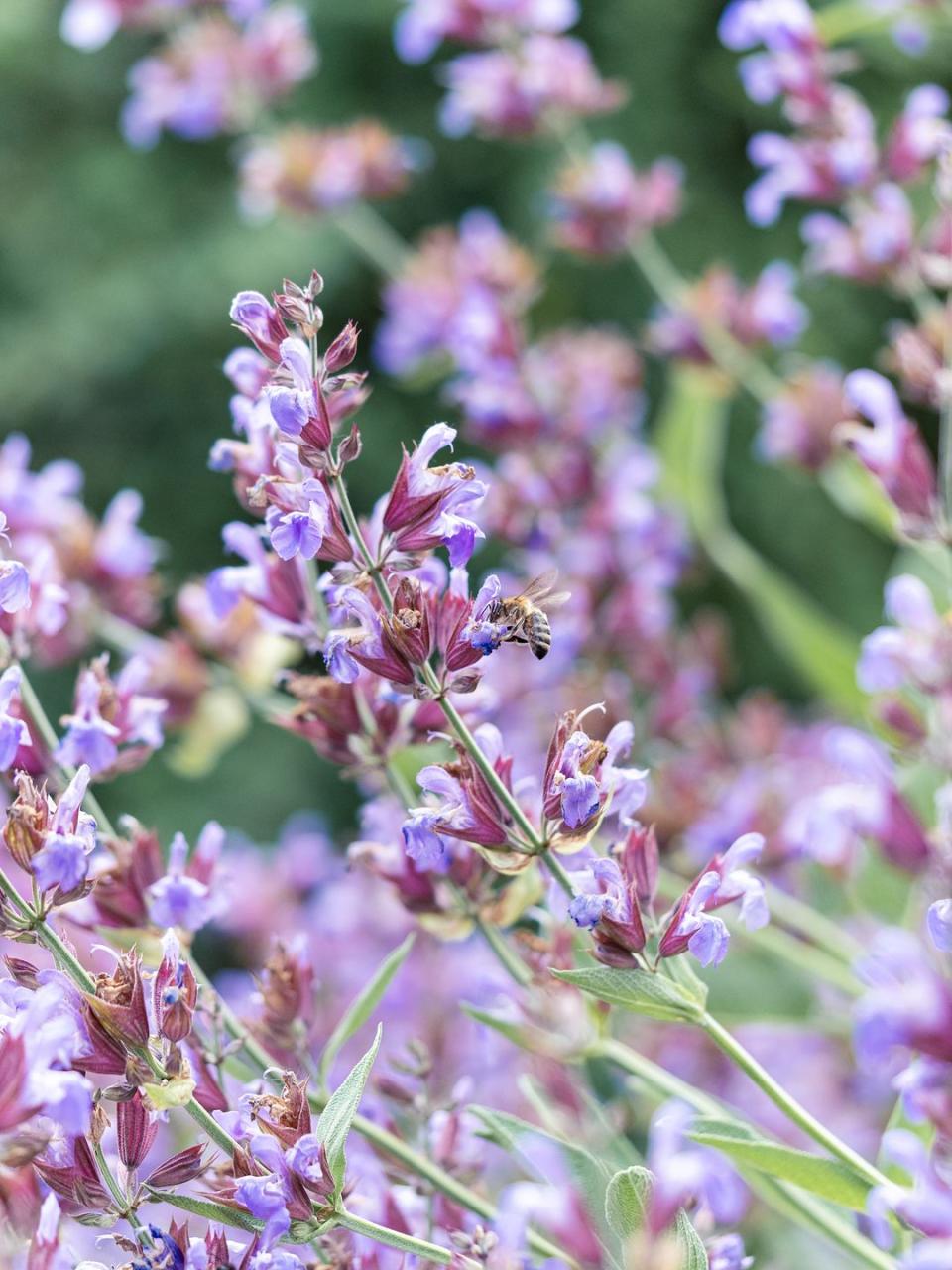
Ornamental salvias, the glamorous cousins of the culinary sage family, are the perfect plant to take you from the end of summer through to autumn. With thousands to choose from in colours from brilliant red through to blues and purples, their small, but profuse flowers just keep coming. Salvia 'Amistad' is a standout favourite. Most salvias are prolific flowerers and 'Amistad' blooms are a fantastic shade of midnight purple that positively glows in the low autumn sunshine. You will often find it flowering into December.
Although officially a sun lover in need of well-drained soil, this is one of those plants that doesn't quite follow the rules. It is tolerant of shadier areas, but the flowers might appear a little later than if it were in full sun. It's also billed as not fully frost hardy, but it will survive the winters in a sheltered spot and with a good mulch to protect the roots; and even if it looks as if the worst of the winter weather has beaten it, cut back in late winter and it will have no problem at all in growing back to its full glory the following summer. Salvias are also very easy to propagate, so you can plan ahead and insure against winter losses by taking cuttings in late summer.
November border plant: Nerines
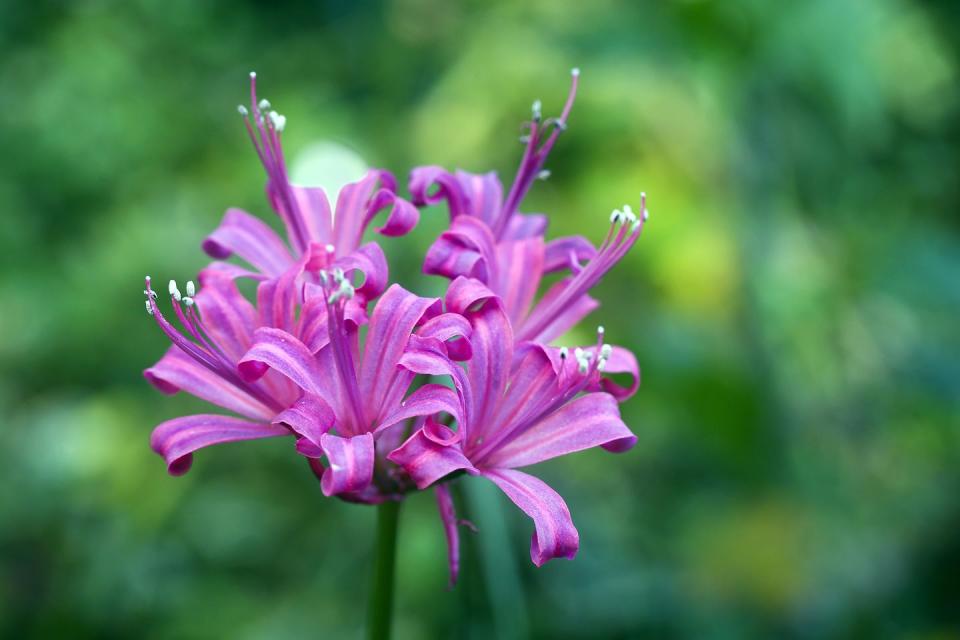
While in spring we are spoilt for choice with a whole carnival of flowering bulbs, the autumn offering is more limited and the flowering beauty of the season is Nerine bowdenii. A south African bulb, this will suit more sheltered gardens, where the flowers can be enjoyed, safe from frosts, well into November. In shades of candy pink, through to bright red, the lily-like blooms on long stems are elegant and will add an unexpected exotic flourish to your November border.
Plant nerine bulbs in spring, choosing a sunny spot, with open, well-drained soil – add some grit when you plant to make sure there is no chance for the soil to get too heavy and wet. Cut back the foliage as the plants die back over winter and mulch generously to protect them from hard frosts.
December border plant: Christmas box, Sarcococca confusa
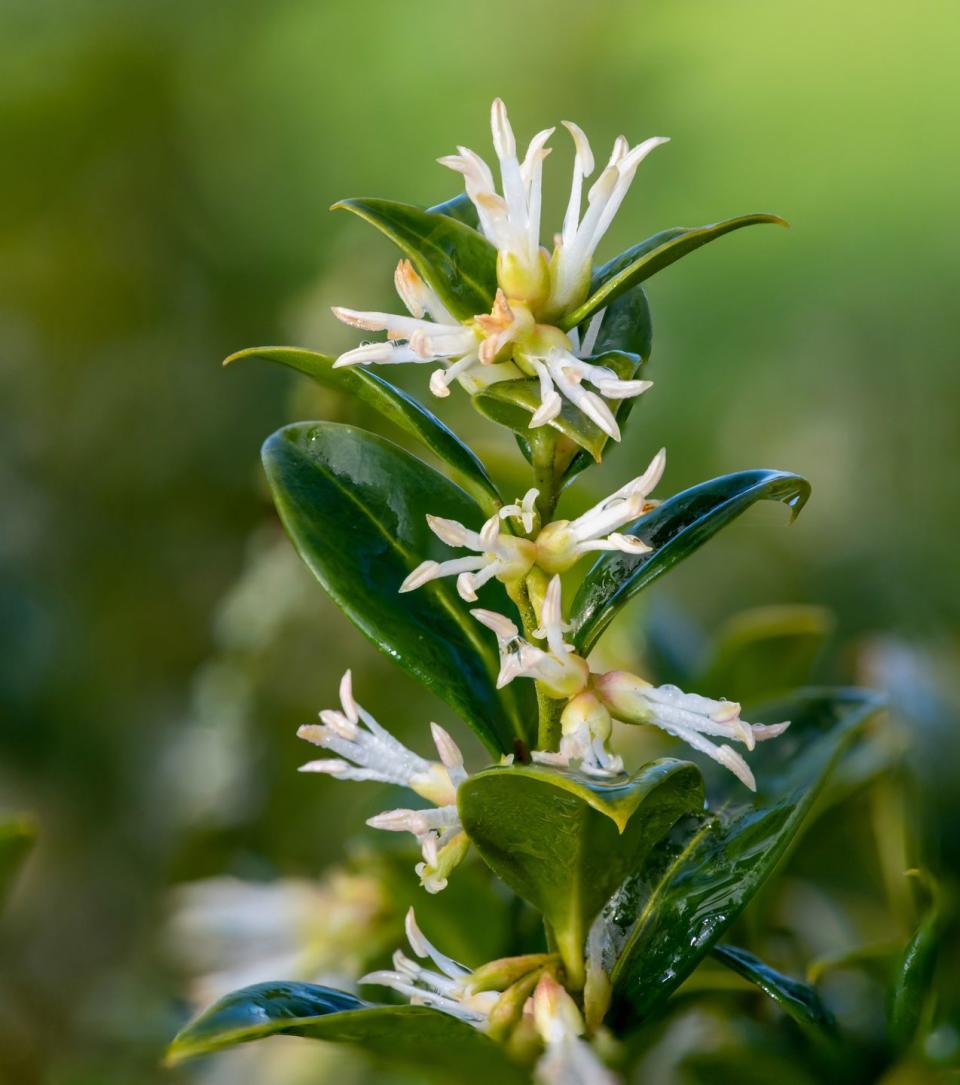
In December, evergreens take centre stage, providing strong blocks of dark coloured foliage and structure, a perfect foil for frosty days and winter berries and the elite winter flowering shrubs like the sweetly scented Viburnum x bodnantense 'Dawn'. Midwinter is the time to put the spotlight on hardworking plants that give a little bit extra and sweet Christmas box, Sarcococca confusa, is a great addition to any garden border, larger or small. This compact, low-growing evergreen makes the perfect punctuation mark. When all around has died back or left skeleton seedheads, sarcococca is brilliant, lush and shiny green with the added bonus of amazing, scented flowers. You have to look hard for the flowers – they are tiny, but wow! If you've walked through a garden or park in winter, and had your head turned by an amazing perfume, it's almost certainly going to be sarcococca. It's also a great choice for dry shade as well as containers and needs no clipping or pruning, so it's a real winter winner.
January border plant: Hellebores
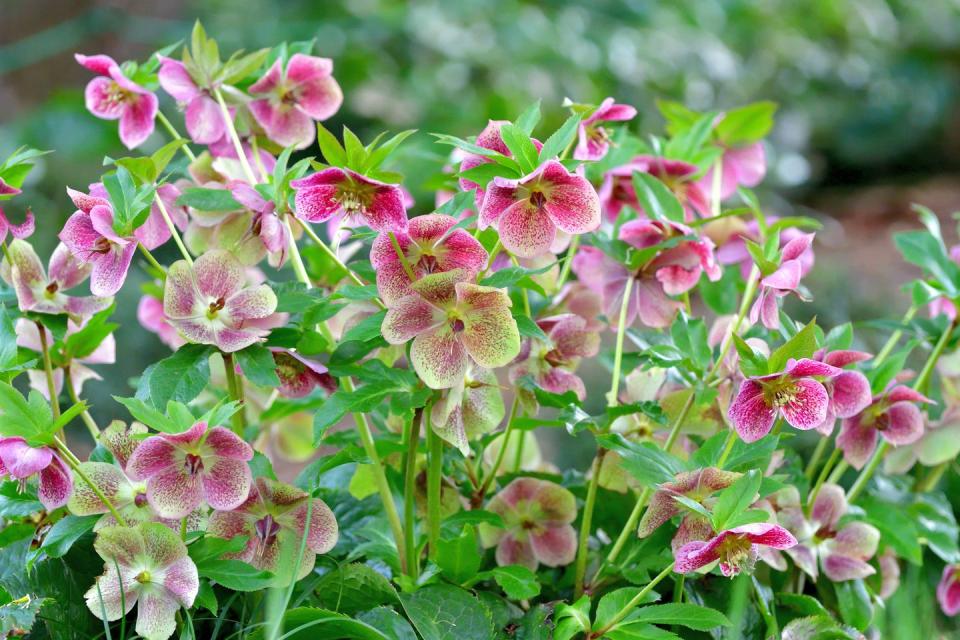
As the new year beds in, hellebore season is in full swing. These are true winter showstoppers, with many hybrids and varieties to choose from that will flower from December until March. At this barren time of year, they are perfectly placed to be admired in all their delicate detail, both in the garden and cut for indoors where the flowers are best displayed floating face up in a water bowl. In the garden, hellebores have the added bonus of semi-evergreen leaves, which emerge fresh and shiny in spring to make good structural foliage through the summer months. Hybrid hellebores, mostly from crosses between helleborus niger, the Christmas rose, and orientalis, the Lenten rose, offer flowers ranging from simple singles to more frilly, voluptuous doubles. There are variations in colour too, from sparkling white through to speckled, dusky pinks, to glamorous almost-black shades of purple.
Hellebores are a great choice for shady borders and look good planted in small groups or drifts through other low-growing shrubs, grasses and early-flowering bulbs. They are perfect for achieving a natural, woodland look if you have space, but they look equally good planted in containers.
February border plant: Hardy cyclamen
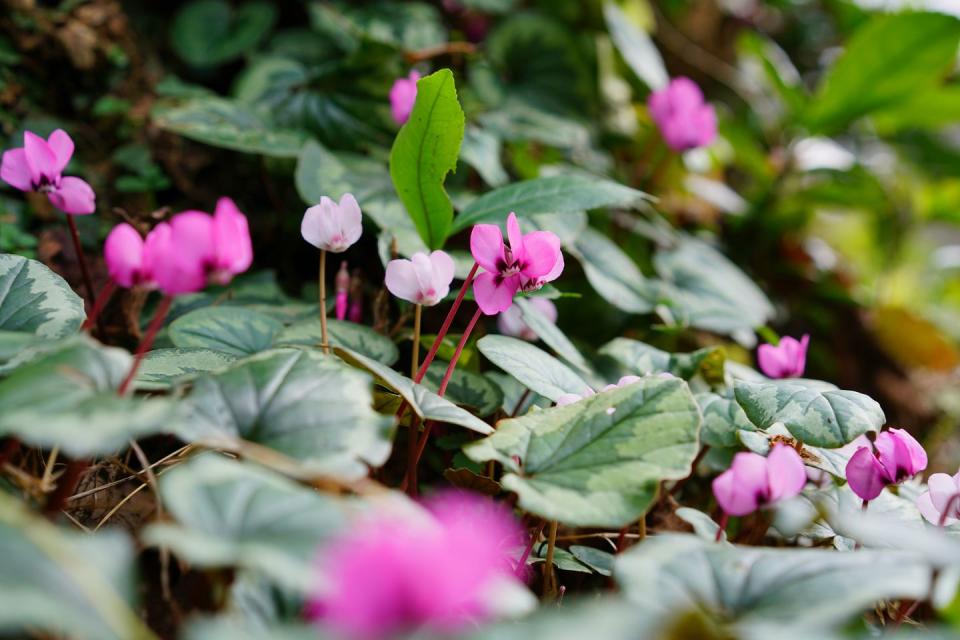
As the earliest spring bloomers emerge, look at your feet for carpets of snowdrops, winter aconite, crocus, chionodoxa and iris reticulata. But before the full palette of new season blues and yellows explodes, there is nothing like the dainty blooms of hardy cyclamen to brighten up your winter borders. Guaranteed to bring cheer, they range in colour from purest white through to pink to rich red. These tiny, elegant, jewel-like flowers are offset by gorgeous, silver-mottled leaves.
A good choice for shadier corners, plant hardy cyclamen at the front of your borders or at the foot of smaller trees where they can be admired. The intensely coloured flowers will keep coming steadfastly right through until March. Plant the tiny, doughnut-shaped corms in September, not too deep, into good, open soil, adding a winter mulch for protection. Hardy cyclamen are perennials, and will come up every year, multiplying in the right conditions, so you will end up with a colourful spread of blooms through your garden borders. Plant them among other woodland dwellers such as ferns and evergreen grasses such as carex and luzula.
March border plant: Wallflowers
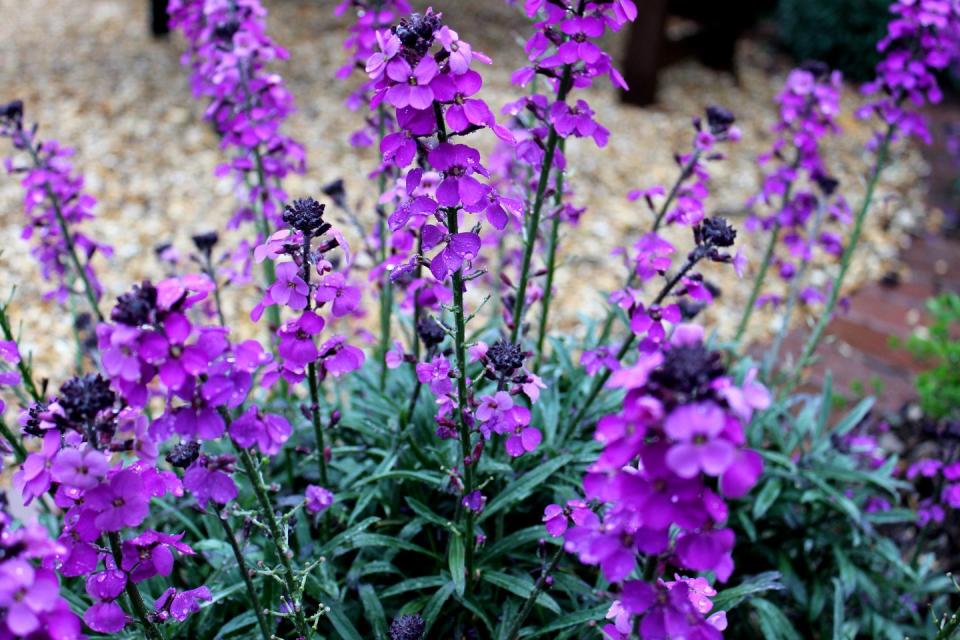
Although we're used to thinking ahead to our spring bulb displays, it's just as important to plan what they will grow with. As those first shoots emerge, wallflowers (Erysimum) will set the stage perfectly for the incoming tulips and daffodils. With contrasting flower styles, size and foliage, wallflowers are scented too and make great companion plants that will carry borders and containers through the changing seasons. The flowers begin to appear in late March, so plant wallflowers for spring bulbs to grow through. When these begin to fade and die back, the wallflowers will hide the spent stems allowing them to disappear gracefully from your borders. They will continue to look good for many months.
Although technically grown as biennials and planted out as spring bedding, wallflowers are short-lived perennials with a very long flowering season. They are easy to grow, either from seed – sow in May for flowers the following spring – or order as bare-root plug plants and plant out in the autumn. They need a sunny spot with well-drained, fertile soil. There's a range of gorgeous colours to choose from, whether it's the acid yellow of perennial 'Walberton's Fragrant Sunshine' through to the oranges of E. cheiri varieties and the purple of the shrubby perennial wallflower, 'Bowles' Mauve'.
Follow House Beautiful on TikTok and Instagram.
You Might Also Like

 Yahoo Finance
Yahoo Finance 
